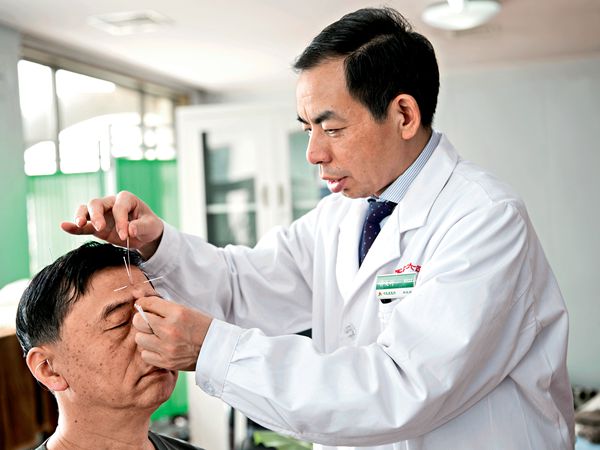Pioneer of Medical Model Reform
China Today, February 8, 2017 Adjust font size:

Jiang Geli treats a patient with acupuncture according to his philosophy of humanistic holistic medicine.
Based on medical practice, we seek integration of diverse schools, including those of philosophy, medical science, and life sciences, from the perspectives of human science and philosophy. Meanwhile, bold theoretical explorations and technical innovations have facilitated establishment of the humanistic holistic concept, the three-dimensional (body, mind, and spirit) precept of the human body, and the four-dimensional (body, mind, spirit, and environment) outlook on life. These have evolved into the humanistic holistic medical model that has polarized the attention of medical circles.
CT: What is the fundamental connotation of the humanistic holistic medical model? And what are the main features of this new model compared with its existing counterparts?
Jiang: The humanistic holistic medical model is based on the substantive characteristics and treatment principles of medical science. It complies with the development trend of medical science and contemporary demands for better physical and mental health. Human orientation is one of its fundamental connotations. Moreover, the model imbues the philosophy of life, the essence of Chinese and Western medicine, and modern life science and technology, so integrating biology (the human body, its activities and metabolism), ecology (the internal and external environment of human body), emotions (psychology, the spirit, and intelligence), and society (interpersonal family and social relationships). Characterized by green concepts, holistic adjustment, and humanistic science and technology, the emphasis of the new medical model is on treating and maintaining health on the four dimensions of body, mind, spirit, and environment.
The current medical model was formulated by American psychiatrist George L. Engel in 1977. Different from traditional model, Engel’s theory highlights biological, psychological, and social influences. This model, however, failed to function as expected due to several academic flaws. We are therefore calling for a more scientific, human-oriented, integrated and precise model that will meet the needs of this era.
Humanistic holistic medicine came into being against this backdrop. On one hand, it contributes to practicing and passing down TCM theories and techniques that underline the equilibrium between yin and yang, as well as an overall analysis of illnesses. On the other, it promotes integration of TCM and Western medicine, and better utilization of modern science and technology. The new model, through a more advanced system and greater perception, is better adjusted to contemporary human health conditions and their demands on health care. Its innovative four major medical scientific concepts are the model’s main features.
First, compared with Engel’s biopsychosocial model, the four-dimensional concept of medicine – biology, psychology, society, and ecology – have broadened our horizons by taking full consideration of the influence of environmental changes on human health.
Second, the four-dimensional concept of healthcare – the physical body, emotions, mentality, and environment – takes account of growing and worsening psychogenic pathogenic factors and their relevance to patients, the need for higher medical integrity and more specific medical treatment.
Third, the epochal strategy that makes TCM more human-oriented, technologically advanced, greener, and popular globally highlights the advantages of TCM, which is integrating into the world with confidence and expected to fulfill epoch-making revitalization and further achievements.
Fourth, the concept of “inclusive transcendence” blends the philosophies of TCM and Western medicine. The merging of Chinese and Western medicine – from theory to practice – is an inevitable requirement of this era, and a trend in world medical development.